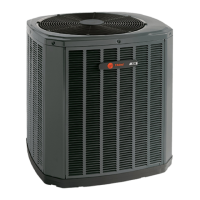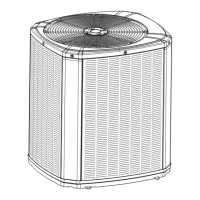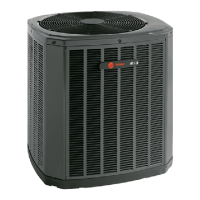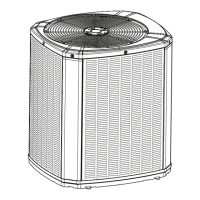|nstaI|er's Guide
@
BASEPAN TAB REMOVAL
NOTE:
Attach R-410A CAUTION Label (located in documentation
package) to access panel of indoor section.
IMPORTANT:
The outdoor unit is shipped withthe proper size orifice and a
stick-on orifice size label in an envelope attached to the outdoor
unit. Outdoor unit nameplate will have correct orifice size
specified as BA YFCCV---A for rated pefformance.
D. iNSTALLiNG REFRIGERANT LINES
3. The support pad must NOT be in direct contact with any
structure. Unit must be positioned a minimum of 12"
from any wall or surrounding shrubbery to insure
adequate airflow. Clearance must be provided in ff'ont of
control box (access panels) & any other side requiring
service access to meet National Electrical Code. Also,
the unit location must be fhr enough away from any
structure to prevent excess roof run-off water from
pouring directly on the unit. Do not locate unit(s) close
to bedroom(s).
4. The top discharge area must be unrestricted fbr at least
five (5) feet above the unit.
5. When the outdoor unit is mounted on a roof! be sure the
roof will support the unit's weight. Properly selected
isolation is recommended to prevent sound or vibration
transmission to the building structure.
6. The maximum length of refrigerant lines ff'om outdoor to
indoor unit should NOT exceed sixty (60) feet.
7. If outdoor unit is mounted above the air handler, maxi-
mum lift should not exceed sixty (60) feet (suction line).
If air handler is mounted above condensing unit, maxi-
mmn lift should not exceed sixty (60) feet (liquid line).
NOTE:
Refer to "Refrigerant Piping Software" Pub. No. 32-3312-02.
8. Locate and install indoor coil or air handler in accor-
dance with instruction included with that unit.
C. ACCUTRON TM FLOW CONTROL VALVE
If the indoor unit System Refrigerant Flow control is an
Aecutron TM orifice and check valve assembly, an orifice size
change may be necessary.
The outdoor model determines the required orifice size.
Check the listed orifice size on nameplate of the selected
outdoor model. If the indoor unit is fhctory shipped with a
diffbrent orifice size, the orifice must be changed to obtain
system rated perfbrmance.
BRAZE TYPE iNDOOR END
SEALING CAP
If using existing refrigerant lines make certain that all joints
are brazed, not soldered.
Condensing units have provisions for braze connections.
Pressure taps are provided on the service valves of outdoor
unit fbr compressor suction and liquid pressures.
The indoor end of the recommended refrigerant line sets may
be straight or with a 90 degree bend, depending upon situa-
tion requirements. This should be thoroughly checked out
befbre ordering refrigerant line sets.
The gas line must always be insulated.
in scroll compressor applications, dome temperatures may
be hot. Do not touch top of compressor, may cause minor
to severe burning.
The units are fhctory charged with the system charge
required when using fifteen (15) feet of connecting line. Unit
nameplate charge is the same.
Final refrigerant charge adjustment is necessary. Use
the Charging Charts in the outdoor unit Service Facts.
1. Determine the most practical way to run the lines.
2. Consider types of bends to be made and space limitations.
NOTE:
Large diameter tubing will be very difficult to rebend once it
has been shaped.
3. Determine the best starting point for routing the refriger-
ant tubing -- INSIDE OR OUTSIDE THE STRUCTURE.
4. Provide a pull-thru hole of sufficient size to allow both
liquid and gas lines.
5. Be sure the tubing is of sufficient length.
6. Uncoil the tubing -- do not kink or dent.
7. Route the tubing making all required bends and properly
secure the tubing betbre making connections.
8. To prevent a noise within the building structure due to
vibration transmission from the reff'igerant lines, the
tbllowing precautions should be taken:
a. When the refrigerant lines have to be thstened to floor
joists or other ff'aming in a structure, use isolation
type hangers.
b. Isolation hangers should also be used when reff'iger-
ant lines are run in stud spaces or enclosed ceilings.
c. Where the reff'igerant lines run through a wall or sill,
they should be insulated and isolated.
d. Isolate the lines from all ductwork.
© 2008 American Standard Heating & Air Conditioning 18-AC51 D6-1

